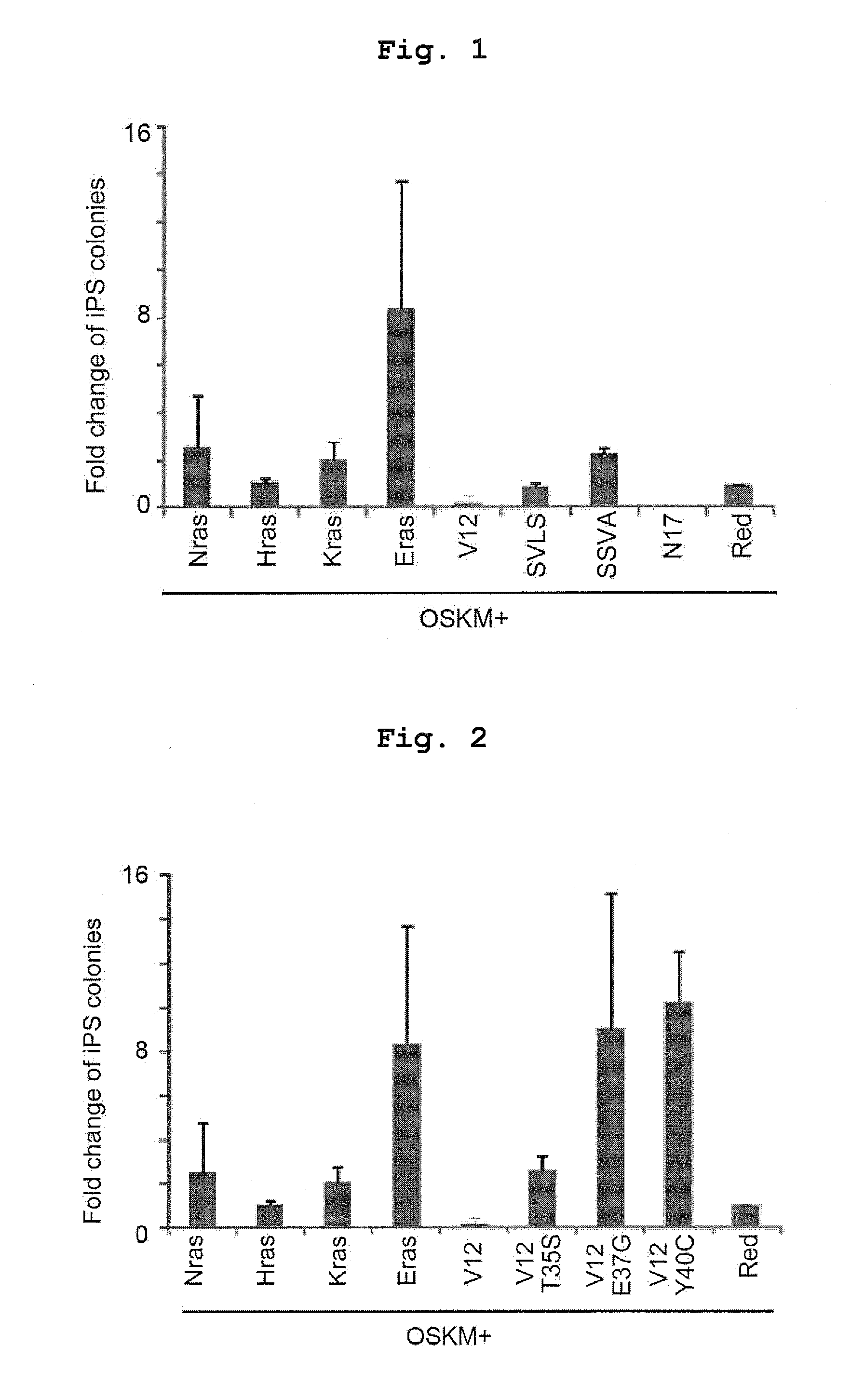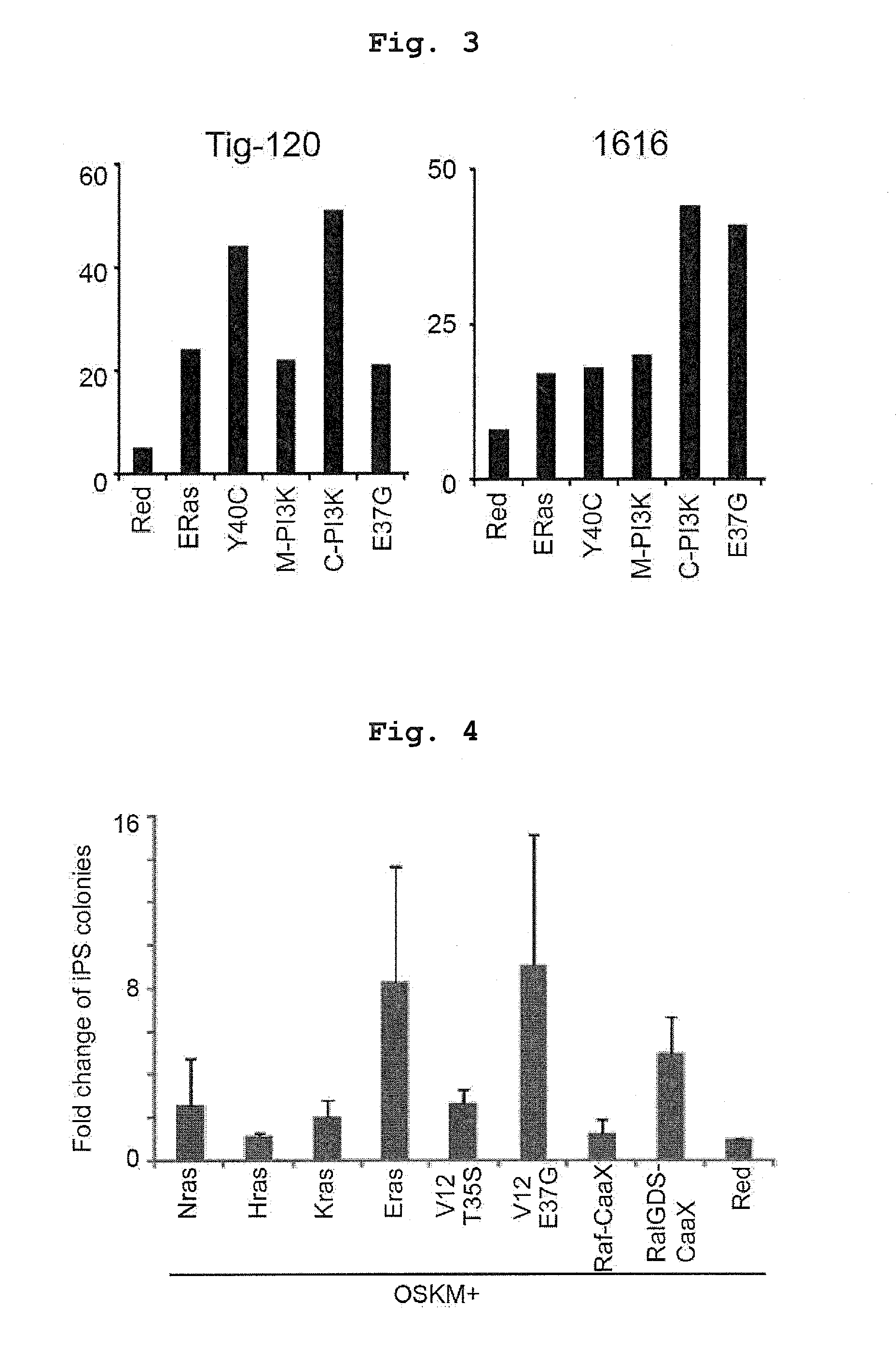Efficient method for establishing induced pluripotent stem cells
a technology establishment efficiency, which is applied in the field of improving the establishment efficiency of induced pluripotent stem cells, can solve the problems of low tumorigenesis in tissues or individuals, and achieves enhanced ips cell establishment efficiency, low establishment efficiency, and increased activation level
- Summary
- Abstract
- Description
- Claims
- Application Information
AI Technical Summary
Benefits of technology
Problems solved by technology
Method used
Image
Examples
example 1
Consideration of Effect of Ras Family on Human iPS Cell Establishment
[0143]Whether or not Ras family (Nras, Hras, Kras and Eras) has an effect on iPS cell establishment was examined.
[0144]Fibroblasts (HDF) derived from the skin of an adult (a 73-year-old female Caucasian, name of cell line 1503) were allowed to express the mouse ecotropic virus receptor Slc7a1 gene using a lentivirus (pLenti6 / UbC-Slc7a1), as described by Takahashi, K. et al. in Cell, 131:861-872 (2007). These cells (1×105 cells / well, 6-well plate) were transfected with the following genes using a retrovirus, as described by Takahashi, K. et al. in Cell, 131:861-872 (2007), and the number of the resultant iPS cell colonies was compared to that obtained by introduction of 4 genes (Oct3 / 4, Sox2, Klf4, c-Myc).
1) Human Oct3 / 4, Sox2, Klf4, c-Myc, Nras
2) Human Oct3 / 4, Sox2, Klf4, c-Myc, Hras
3) Human Oct3 / 4, Sox2, Klf4, c-Myc, Kras
4) Human Oct3 / 4, Sox2, Klf4, c-Myc, Eras
5) Human Oct3 / 4, Sox2, Klf4, c-Myc, V12
6) Human Oct3 / 4...
example 2
Consideration of Effect of Ras Signal Transduction Pathway on Human iPS Cell Establishment (1)
[0149]Among three pathways of the MAP kinase pathway, PI3 kinase pathway and Ral pathway (RalGEF pathway) which are Ras signal transduction pathways, whether or not the activation of any signal transduction pathways has an effect on iPS cell establishment was examined. The following combinations were used for the experiment which was performed in the same manner as in Example 1.
1) Human Oct3 / 4, Sox2, Klf4, c-Myc, Nras
2) Human Oct3 / 4, Sox2, Klf4, c-Myc, Hras
3) Human Oct3 / 4, Sox2, Klf4, c-Myc, Kras
4) Human Oct3 / 4, Sox2, Klf4, c-Myc, Eras
5) Human Oct3 / 4, Sox2, Klf4, c-Myc, V12
6) Human Oct3 / 4, Sox2, Klf4, c-Myc, V12T35S
7) Human Oct3 / 4, Sox2, Klf4, c-Myc, V12E37G
8) Human Oct3 / 4, Sox2, Klf4, c-Myc, V12Y40C
[0150]Here, “V12T35S” is a mutant wherein the MAP kinase pathway is selectively and constitutively activated by the substitution of the 12th glycine of HRas by valine and the 35th threonine by s...
example 3
Consideration of Effect on Different Cells
[0154]Using dermal fibroblasts of 6-year-old Japanese female (cell name: TIG120) and dermal fibroblasts of 68-year-old Japanese female (cell name: 1616), an experiment similar to that in the aforementioned Example was performed in the following combinations.
1) Human Oct3 / 4, Sox2, Klf4, c-Myc, Eras
2) Human Oct3 / 4, Sox2, Klf4, c-Myc, V12Y40C (simply shown as “Y40C” in FIG. 3)
3) Human Oct3 / 4, Sox2, Klf4, c-Myc, Myr-PI3K (simply shown as “M-PI3K” in FIG. 3)
4) Human Oct3 / 4, Sox2, Klf4, c-Myc, PI3K-CaaX (simply shown as “C-PI3K” in FIG. 3)
5) Human Oct3 / 4, Sox2, Klf4, c-Myc, V12E37G (simply shown as “E37G” in FIG. 3)
[0155]Here, “Myr-PI3K (M-PI3K)” is a constitutively active PI3 kinase localized in the membrane by the addition of a myristoylation signal sequence to the N-terminus.
[0156]The “PI3K-CaaX (C-PI3K)” is a constitutively active PI3 kinase catalytic subunit localized in the membrane by the addition of a Caax motif sequence to the C-terminus....
PUM
 Login to View More
Login to View More Abstract
Description
Claims
Application Information
 Login to View More
Login to View More - R&D
- Intellectual Property
- Life Sciences
- Materials
- Tech Scout
- Unparalleled Data Quality
- Higher Quality Content
- 60% Fewer Hallucinations
Browse by: Latest US Patents, China's latest patents, Technical Efficacy Thesaurus, Application Domain, Technology Topic, Popular Technical Reports.
© 2025 PatSnap. All rights reserved.Legal|Privacy policy|Modern Slavery Act Transparency Statement|Sitemap|About US| Contact US: help@patsnap.com



